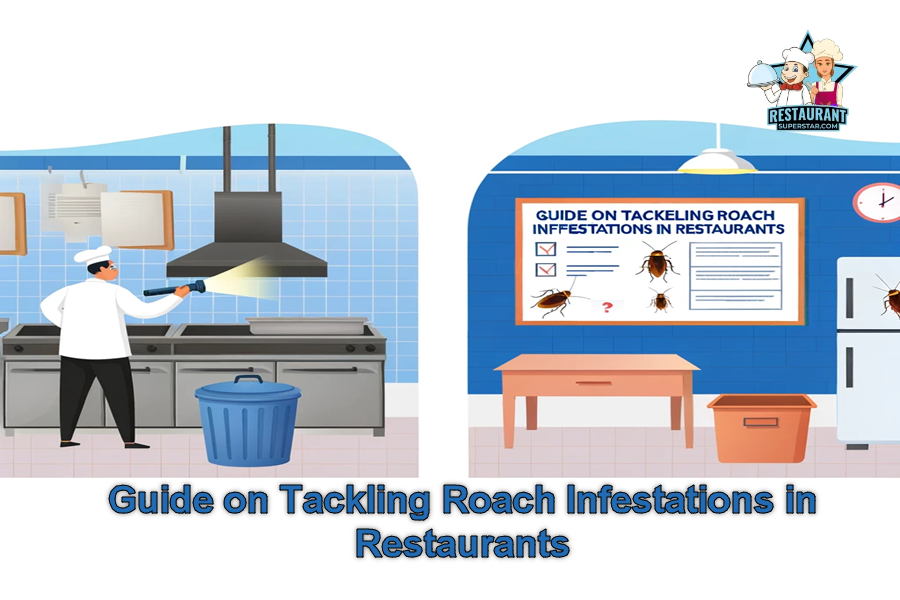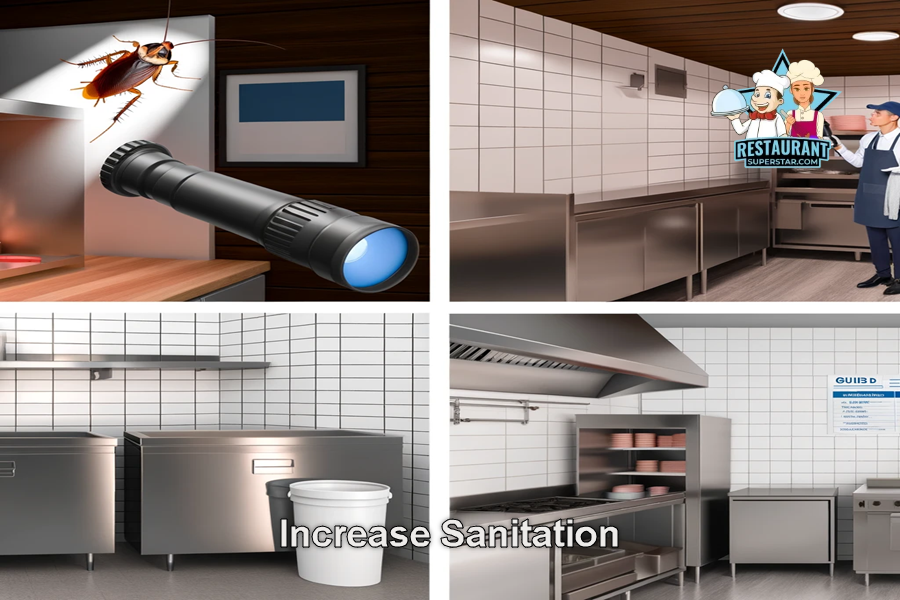How to Get Rid of Roaches in Your Restaurant
Do you need help with a roach problem in your restaurant? You’re in the right place. Our comprehensive guide is crafted to answer “How to Get Rid of Roaches in Your Restaurant?” and delve into essential topics for maintaining a hygienic dining environment.
This article is your one-stop solution to eradicate roaches and boost your restaurant’s cleanliness.
How to Get Rid of Roaches in Your Restaurant?
How to Get Rid of Roaches in Your Restaurant? To effectively eliminate roaches in your restaurant, you need professional pest control, rigorous sanitation, strategic sealing of entry points, and diligent food storage and waste management.
This article unveils more than just these steps; it’s a treasure trove of insights and expert tips.
Keep reading to discover all you need about banishing roaches for good and maintaining your restaurant’s pristine, pest-free environment.
Guide on Tackling Roach Infestations in Restaurants

Welcome to our practical guide on tackling a common yet critical challenge in the culinary world: roach infestations in restaurants. Suppose you’re a new restaurant owner, a budding chef, or simply someone interested in the ins and outs of restaurant management. In that case, this is vital information for you.
Why Managing Cockroach Infestations Is Crucial
First things first, let’s talk about why dealing with cockroaches is not just important but essential for your restaurant:
Health and Hygiene: Roaches aren’t just unsightly; they’re carriers of numerous pathogens. These unwelcome guests can spread bacteria like E. coli and Salmonella, seriously risking your customers’ health.
Imagine a tiny, six-legged creature trekking from unmentionable places right onto your kitchen counters – not a pretty picture, right?
Customer Experience: Picture this: a diner spots a roach scurrying across the floor. That’s all it takes – just one sighting and your restaurant’s reputation could take a nosedive. In the age of online reviews and social media, news travels fast, as does bad publicity.
Operational Efficiency: Cockroaches can also cause physical damage. They love to gnaw on organic materials, including paper and packaging, potentially ruining your storeroom supplies.
The Hidden Costs: Reputation and Health Risks
Let us go into more detail about the health hazards and possible harm to your restaurant’s reputation now:
Health Hazards: These critters can contaminate food and food preparation surfaces. The health of your customers may be at risk due to this contamination, which can cause foodborne illnesses. And it’s not just about the immediate health risks; it’s about the trust your customers place in your establishment.
Reputation Damage: In the restaurant business, reputation is everything. A single incident involving roaches can lead to negative reviews, reduced patronage, and even closure notices from health inspectors.
It’s a slippery slope one minor issue can escalate into a full-blown crisis if not managed promptly and effectively.
Managing cockroach infestations is more than a cleanliness task; it’s about safeguarding the health of your patrons and your establishment’s reputation.
Stay tuned as we dive into practical strategies to keep your restaurant roach-free and thriving.
Whether you’re just starting or looking to refine your pest management approach, we’ve got you covered. Join us as we delve into maintaining a clean and safe kitchen sanctuary.
Immediate Action Steps
Contact a Pest Control Professional
When it comes to roaches in your restaurant, sometimes the DIY approach just doesn’t cut it. This is where calling in the pros becomes essential. Let’s break down why reaching out to a pest control professional is a crucial step and what you can expect from their services:
Why Professional Intervention is a Must
Expertise and Experience: Pest control specialists have the expertise to manage infestations effectively. They know exactly where to look, what to look for, and how to get rid of roaches. They’re like the Sherlock Holmes of the pest world – no corner is too hidden, no crevice too small.
Advanced Solutions: Professionals can access more potent and effective treatments than what’s available over the counter. These solutions are often more sustainable and long-lasting, ensuring they don’t check back in once the roaches check out.
Safety First: These experts know how to handle chemicals and treatments safely, ensuring that your staff and customers are not exposed to harmful substances. They’ll ensure your restaurant remains a safe place to dine, even as they wage war against the roaches.
What to Expect from a Pest Control Service
1. Assessment: The first thing a pest control service will do is assess the situation. They’ll inspect your restaurant to determine the extent of the infestation and identify the types of roaches you’re dealing with.
2. Treatment Plan: After conducting an assessment, they will suggest a customized plan of care to meet your requirements. This could include a combination of baiting, spraying, and sealing entry points.
3. Execution: The professionals will then get down to business, implementing the treatment plan with precision and care. They’ll target key areas like kitchens, storage rooms, and other hot spots.
4. Follow-Up and Maintenance: Good pest control services don’t just hit and run. They’ll offer follow-up visits to ensure the roaches haven’t returned and provide tips for long-term prevention.
5. Education: Expect them to educate you and your staff on how to prevent future infestations. This might include tips on proper food storage, waste management, and identifying early signs of a comeback.
Increase Sanitation

Boosting cleanliness in your restaurant is a game-changer in the fight against roaches. Let’s walk through some detailed steps for deep cleaning key areas and share some handy tips on managing crumbs, spills, and grease.
Deep Cleaning Key Areas: A Step-by-Step Approach
1. Focus on the Kitchen: Begin with the heart of your restaurant. Disinfect all surfaces, including counters, stovetops, and cutting boards. Remember the less obvious spots like the tops of cabinets and underneath appliances.
2. Storage Areas: Clean and organize your storage rooms. Make sure that every food item is kept in sealed containers. Regularly check for and dispose of outdated or damaged goods that attract pests.
3. Dining Area: Clean tables, chairs, and floors daily. Pay special attention to corners and under-table areas where food particles often accumulate.
4. Restrooms: These should be spotless. Clean and sanitize all surfaces, including floors, toilets, and sinks. Ensure there’s no standing water anywhere, as it attracts roaches.
5. Drains and Pipes: Regularly clean drains and pipes, as these can be both a water source and entry point for roaches.
Managing Crumbs, Spills, and Grease: Pro Tips
Immediate Clean-up: Train your staff to clean up food crumbs and spills immediately. The longer they sit, the more they attract roaches.
Regular Sweeping and Mopping: Sweep floors throughout the day and mop at least once after closing. Use a disinfectant cleaner to remove all food particles and potential attractants.
Grease Management: Regularly clean grills, ovens, and fryers to prevent grease build-up. Remember to clean the grease traps, which are a significant draw for roaches.
Trash Management: Empty trash bins several times daily, especially in the kitchen and dining area. Use bins with tight-fitting lids to deter roaches.
Inspect and Clean Appliances: Regularly pull out appliances to clean behind and underneath them. Food particles and grease often accumulate in these hidden areas.
Seal Entry Points
An essential step in keeping roaches out of your restaurant is identifying and sealing their potential entry points. This preventative measure is as crucial as any cleaning or baiting strategy. Let’s explore how to seal off these unwelcome gateways effectively.
Identifying Common Entry Points for Roaches
1. Cracks and Crevices: Start with thoroughly inspecting your restaurant. Examine the ceiling, floors, and walls for any cracks. Don’t overlook the areas where utilities (like pipes and wires) enter the building.
2. Windows and Doors: Check for gaps around window frames and under doors. Even small openings can be a welcome sign for roaches.
3. Drains and Pipes: Areas around plumbing are often overlooked, yet they’re common entry points. Inspect sinks, toilets, and floor drains.
4. Vents and Exhaust Fans: Ensure that vents, including those in the kitchen and bathrooms, are properly screened and sealed.
5. Storage Areas: Roaches can hitch a ride on boxes and bags. Inspect deliveries and keep storage areas clutter-free to reduce hiding spots.
Materials and Methods for Effective Sealing
Caulk: Use silicone caulk to seal cracks and gaps in floors, walls, and the spaces around windows and doors. It’s durable and provides a long-lasting seal.
Weatherstripping: Apply weatherstripping to door and window frames. This not only keeps pests out but also helps with energy efficiency.
Mesh Screens: Install fine mesh screens on vents and windows. This allows air to circulate while keeping roaches and other pests at bay.
Steel Wool and Foam: Use steel wool or expanding foam for more significant gaps, especially around pipes and utilities. Roaches need help to chew through these materials.
Door Sweeps: Fit door sweeps to the bottom of your doors, especially those leading to the outside or storage areas, to block off this common entry point.
Proper Food Storage
Proper food storage, including pesky roaches, is a cornerstone of pest prevention. By storing food correctly, you maintain its quality and minimize the risk of attracting unwanted guests.
Here’s a guide to ensure your food storage practices are up to the mark.
Guidelines for Airtight Food Storage
1. Use Airtight Containers: Store dry goods like flour, sugar, grains, and cereals in airtight containers. This prevents roaches from smelling and accessing these food sources.
2. Refrigerate Perishables: Promptly refrigerate perishable items. Roaches are attracted to rotting food, so keeping perishables cool inhibits spoilage and deters pests.
3. Label and Rotate Stock: Practice FIFO (First In, First Out). Label all items with dates and use the oldest stock first. This reduces the chance of food becoming stale and attracting roaches.
4. Seal Opened Packages: Ensure opened packages in storage areas are tightly resealed. Using clips or resealable bags can prevent roaches from sniffing out the contents.
5. Regular Inventory Checks: Check your inventory for signs of pest activity or contaminated food. Discard any compromised items immediately.
Best Practices for Avoiding Food Scraps and Dirty Dishes
1. Clean As You Go: Encourage a clean-as-you-go policy in the kitchen. This means wiping down surfaces and cleaning up spills immediately.
2. Nightly Clean-Up: Ensure all food prep areas are thoroughly cleaned at the end of each day. This includes washing all dishes, utensils, and cooking equipment.
3. Secure Garbage Bins: Dispose of food scraps in bins with tight-fitting lids. Regularly empty these bins and clean them to remove any lingering food residue.
4. Scheduled Deep Cleaning: Set a routine for deep cleaning, focusing on areas beneath and behind kitchen equipment where food scraps can accumulate.
5. Employee Training: Train your staff on maintaining cleanliness. Everyone should know their role in keeping the kitchen free of food scraps and dirty dishes.
Regular Trash Disposal
Effective trash disposal plays a pivotal role in maintaining a roach-free restaurant. These critters are attracted to the odors and residues commonly found in garbage, making diligent trash management necessary.
Let’s dive into why regular trash disposal and the best practices for maintaining your trash bins are crucial.
Importance of Daily Trash Removal
1. Minimizing Attraction: Garbage, especially food waste, is a major draw for roaches. Removing trash daily significantly reduces the aromas and residues that lure these pests.
2. Preventing Infestation: Regular disposal prevents the accumulation of waste that can quickly become a breeding ground for roaches.
3. Enhancing Hygiene: Daily trash removal is key to maintaining your restaurant’s cleanliness and hygiene, contributing to a healthier environment for staff and customers.
Recommendations for Trash Bin Maintenance
1. Use Lidded Bins: Always use trash bins with tight-fitting lids to contain odors and deny access to roaches.
2. Frequent Emptying: Empty bins at least once daily or more often if they fill up quickly. Never let trash overflow, as it can attract roaches and other pests.
3. Regular Cleaning: Clean the bins regularly to remove any food residue or build-up. Disinfecting the bins can help reduce odors that attract pests.
4. Strategic Placement: Keep trash bins away from food preparation and storage areas. Place them in a designated area that is regularly monitored and cleaned if possible.
5. Liners are Key: Always use bin liners to minimize direct contact between the trash and the bin. This makes for easier and more sanitary disposal.
6. Secure Outdoor Bins: If you have outdoor bins, ensure they are sealed and placed away from entry points into the restaurant. To keep these places from turning into pest hotspots, give them routine inspections and cleanings.
Maintaining Cleanliness: Long-Term Prevention Strategies
Maintaining cleanliness is not just a one-time task in the restaurant business; it’s a continuous commitment that plays a crucial role in preventing roach infestations. Let’s explore how regular cleaning routines and special attention to certain areas can be your long-term strategy to keep those pesky roaches at bay.
Scheduling and Implementing Regular Cleaning Routines
1. Create a Cleaning Schedule: Develop a detailed cleaning schedule that covers daily, weekly, and monthly tasks. This ensures that all areas, especially those prone to neglect, receive regular attention.
2. Daily Tasks: Assign cleaning duties like mopping and sweeping floors, cleaning kitchen equipment, and wiping down surfaces daily. Ensure these tasks are completed without fail each day.
3. Weekly Deep Cleans: Schedule deeper cleaning tasks weekly. This includes scrubbing grills, ovens, and other heavy-duty kitchen equipment and thoroughly cleaning refrigerators and storage areas.
4. Monthly Check-Ups: Dedicate time each month to inspect and clean hard-to-reach areas, such as the tops of shelves, underneath heavy equipment, and behind large appliances.
5. Staff Accountability: Assign specific cleaning tasks to individual staff members or teams. Regularly check to ensure that these tasks are completed effectively and on time.
Focus on Back-of-House and Storage Areas
1. Back-of-House Vigilance: The kitchen and prep areas are critical zones. Ensure no grease or food residue remains on floors, equipment, or surfaces.
2. Storage Area Sanitation: Keep your storage areas well-organized and clean. Regularly inspect and rotate stock, and immediately dispose of damaged or spoiled items.
3. Pest Control Inspections: Include regular pest control inspections as part of your routine. A professional can spot potential problems or areas of concern you might miss.
4. Seal and Secure: Regularly inspect and maintain any seals or closures in storage areas to prevent pests from finding a way in.
5. Clutter-Free Environment: Clutter can provide hiding spots for roaches. Keep back-of-house and storage areas free of unnecessary items and clutter.
Garbage Disposal Management
Efficient garbage disposal management is key to maintaining a hygienic restaurant environment and preventing roach infestations. Here, we’ll discuss the best practices for garbage disposal and odor prevention and when to consider professional grease trap cleaning.
Best Practices for Garbage Disposal and Odor Prevention
1. Separate Organic Waste: Keep organic waste (food scraps) separate from other types of garbage. This helps in managing odors and makes recycling or composting easier.
2. Regular Disposal: Dispose of garbage, especially organic waste, at least once daily. More frequent disposal may be necessary in warmer climates or during busy seasons.
3. Tight-Sealing Containers: Use garbage containers that seal tightly to contain odors and prevent pests from accessing the waste.
4. Clean Bins Regularly: Clean and sanitize garbage bins and disposal areas to eliminate odor-causing bacteria and residue.
5. Immediate Clean-up of Spills: Clean any spills in garbage disposal areas immediately to prevent odors and pest attraction.
6. Odor Control Products: Consider using environmentally-friendly odor control products that neutralize rather than mask smells.
When to Consider Professional Grease Trap Cleaning
1. Frequency of Use: Regular grease trap cleaning is essential if your restaurant has a high volume of greasy waste. The more you use your kitchen, the more often it needs to be cleaned.
2. Odors and Slow Drainage: Persistent foul odors or slow drainage are telltale signs that your grease trap needs attention.
3. Compliance with Regulations: Regular grease trap cleaning is a good practice and often a regulatory requirement. Stay informed about local health and safety standards.
4. After Inspection: If a routine inspection suggests a grease build-up, it’s time to call the professionals.
5. Scheduled Maintenance: Schedule regular professional cleanings based on your restaurant’s usage and local guidelines, even without obvious signs.
Employee Training
In the battle against roaches in your restaurant, your staff are your frontline defenders. It is crucial to educate them on roach identification, prevention, and the importance of immediate reporting of sightings.
Let’s explore how practical employee training can make a significant difference.
Educating Staff on Roach Identification and Prevention
1. Identification Workshops: Conduct training sessions that help staff recognize different types of roaches and signs of infestation. This can include spotting roaches themselves, their droppings, or egg casings.
2. Prevention Techniques: Educate staff on best practices for preventing roaches, like proper food storage, waste management, and cleanliness protocols.
3. Role-Specific Training: Tailor training to different roles. For example, kitchen staff should focus on food waste management, while cleaning staff should concentrate on deep cleaning techniques.
4. Regular Refresher Courses: Pest control is an ongoing process, so regular refresher courses are essential to keep staff updated on the best practices and new prevention methods.
Importance of Immediate Reporting of Roach Sightings
1. Creating a Reporting Protocol: Establish a clear, straightforward procedure for reporting roach sightings. Ensure every team member knows who to report to and how.
2. Encouraging Prompt Reporting: Emphasize the importance of immediate reporting. The sooner a sighting is reported, the quicker action can be taken to address the issue.
3. No-Penalty Policy: Create an environment where staff feel comfortable reporting issues without fear of blame or reprimand. This encourages openness and prompt action.
4. Documentation: Encourage staff to document the location and time of the sighting. Patterns or particular problem areas can be identified with the help of this information.
5. Response Training: Train designated staff on how to respond to reports of roach sightings, including initial steps to take before professional pest control services arrive.
Regular Inspections
Regular inspections are critical to a proactive pest control strategy in restaurants. They help in early detection and prevention of roach infestations. Adequate inspections involve a systematic approach, focusing on potential entry points and hiding spots where roaches are likely to thrive.
Let’s delve into how to carry out these inspections efficiently.
How to Conduct Effective Inspections
1. Develop a Checklist: Create a comprehensive inspection checklist covering all areas of your restaurant. This should include kitchens, dining areas, storage rooms, restrooms, and other potential problem areas.
2. Train Your Team: Ensure key staff members are trained to conduct inspections. They should know what signs to look for, such as live or dead roaches, droppings, egg casings, and unusual odors.
3. Regular Schedule: Set a regular schedule for inspections. Depending on your restaurant’s size and location, this could be weekly, bi-weekly, or monthly.
4. Detailed Examination: Inspect all areas thoroughly. Use a flashlight to check dark, hard-to-reach spaces like under appliances, inside cupboards, and behind furniture.
5. Use Monitoring Tools: Consider using sticky traps or bait stations in strategic locations to monitor for roach activity.
6. Document Findings: Keep a record of inspection results. Note any signs of pests, potential entry points, or areas needing repair or extra cleaning.
Focusing on Potential Entry Points and Hiding Spots
1. Entry Points: Examine doors, windows, vents, and where utility pipes enter your building. Look for cracks, holes, or gaps and seal them promptly.
2. Hiding Spots: Roaches prefer dark, moist areas. Pay special attention to drains, under sinks, refrigeration units, and other kitchen equipment.
3. Food and Water Sources: Look for any possible sources of food or water that roaches might be drawn to. This includes leaky pipes, standing water, and unsecured food items.
4. Exterior Inspection: Remember the outside of your restaurant. Look for areas where roaches could enter or hide, such as garbage disposal areas, and address any issues.
Using Baits and Traps
Baits and traps can be used in addition to routine cleaning and inspections to manage roach populations effectively in a restaurant setting. However, selecting and placing these tools correctly is essential, especially considering the safety in food handling areas. Let’s explore how to use baits and traps effectively as part of your integrated pest management strategy.
Selection and Placement of Baits and Traps in Commercial Settings
1. Choose Commercial-Grade Products: Opt for baits and traps explicitly designed for commercial use. These products are usually more effective and suitable for the higher demands of restaurant environments.
2. Strategic Placement: Place baits and traps where roach activity has been observed or is likely. This includes dark, secluded areas like under sinks, behind appliances, and in storage rooms. Avoid placing them directly in food preparation areas.
3. Variety of Traps: Use a combination of traps, such as sticky traps, bait stations, and gel baits. Each type has its advantages and can be effective in different scenarios.
4. Regular Monitoring and Replacement: Check the traps regularly and replace them as needed. This not only ensures effectiveness but also helps in monitoring the level of roach activity over time.
5. Discreet Placement: Ensure that traps and baits are placed discreetly to avoid alarming customers. They should be out of sight but still in areas where roaches are active.
Safety Considerations in Food Handling Areas
1. Avoid Contamination: Ensure that baits and traps are never placed directly on surfaces where food is prepared or stored. There should always be a clear separation to prevent any risk of contamination.
2. Use Tamper-Resistant Stations: In areas where staff or customers may accidentally come into contact with baits, use tamper-resistant bait stations. These stations protect the bait from being touched while allowing roaches to access it.
3. Follow Instructions Carefully: Always follow the manufacturer’s instructions for using, placing, and disposing of baits and traps. This ensures effectiveness and safety.
4. Inform Your Staff: Ensure your staff knows where baits and traps are. They should also know the safety protocols in case of accidental contact or spillage.
5. Professional Advice: Consult with a pest control professional to determine the best types and placement of baits and traps for your specific situation.
Boric Acid and Other Insecticides
Boric acid and other insecticides can be powerful tools in the fight against roaches in your restaurant. However, using these substances safely and effectively requires careful consideration, especially in a food service environment.
Let’s explore the proper use of boric acid and other insecticide alternatives and their safety considerations.
How and Where to Use Boric Acid Safely
1. Application Sites: Boric acid is most effective when applied to areas where roaches hide and travel, such as under sinks, behind appliances, and along baseboards. Avoid using it directly on surfaces where food is prepared or stored.
2. Method of Application: Apply boric acid as a fine, barely visible dust. Heavy applications can be less practical, as roaches will avoid them.
3. Restrict Accessibility: Because boric acid can be poisonous if consumed, ensure it is applied so kids and animals cannot get it.
4. Cleanliness First: Clean the intended areas thoroughly before applying boric acid. This removes competing food sources that can distract roaches from the bait.
5. Regular Reapplication: Depending on the level of infestation and environmental factors, you may need to reapply boric acid periodically.
Alternatives and Safety Considerations
1. Commercial Insecticides: There are various commercial insecticides available that are formulated for use in commercial kitchens. Look for products labeled for safe use in food handling areas.
2. Gel Baits: Gel baits can be effective and are often safer to use in areas where food is prepared. They can be applied discreetly in cracks and crevices, away from direct contact with food and utensils.
3. Insect Growth Regulators (IGRs): IGRs target the reproductive cycle of roaches and are an excellent long-term solution. They are often used with other treatments for a more comprehensive approach.
4. Safety Protocols: Always follow the manufacturer’s guidelines for safe insecticide application, storage, and disposal. Use personal protective equipment (PPE) as recommended.
5. Professional Assistance: For best results and safety, consider hiring a pest control professional, especially when dealing with severe infestations. More powerful treatments are available to professionals who can administer them securely and efficiently.
Proper Ventilation
Proper ventilation plays a surprisingly significant role in preventing roach infestations in restaurants. Roaches are attracted to humid environments, and good airflow can help to deter them.
Let’s explore the role of ventilation in pest control and provide some tips for maintaining adequate ventilation in your restaurant.
Role of Ventilation in Preventing Roach Infestations
1. Reducing Humidity: Roaches thrive in moist environments. Adequate ventilation helps reduce humidity levels, making your restaurant less inviting to these pests.
2. Eliminating Odors: Good air circulation helps disperse the odors of food and waste, which can attract roaches. Minimizing these odors reduces one of the key attractants for pests.
3. Preventing Condensation: Proper ventilation reduces condensation, especially in areas like the kitchen where steam and heat are prevalent. This helps prevent damp areas where roaches might congregate.
Tips for Maintaining Adequate Ventilation
1. Regular Maintenance of HVAC Systems: Plan regular HVAC (heating, ventilation, and air conditioning) system maintenance and filter changes. This ensures they are working efficiently to circulate and filter air.
2. Use Exhaust Fans: Install and use exhaust fans, especially in the kitchen and restroom areas. These fans help to expel hot, humid air, reducing the overall moisture levels in your restaurant.
3. Proper Airflow in Storage Areas: Ensure storage areas, particularly food and waste, have adequate airflow. By doing this, you can reduce the likelihood of roach infestations by using fans or vents.
4. Managing Windows and Doors: When the weather permits, open windows and doors to improve natural ventilation. However, make sure they are properly screened to prevent pests from entering.
5. Dehumidifiers in High Humidity Areas: In areas with persistently high humidity levels, consider using dehumidifiers to keep the environment dry and less hospitable to roaches.
6. Regular Checks for Air Leaks: Inspect your restaurant for air leaks, particularly around windows and doors. Sealing these leaks helps maintain desired humidity levels and improves energy efficiency.
Conclusion
Successfully managing roach infestations in a restaurant requires a comprehensive and proactive approach. As we conclude, let’s summarize the key steps we’ve discussed for effective roach control, emphasizing the need for quick, thorough action and the ongoing nature of pest management.
Summary of Key Steps for Roach Control in Restaurants
1. Professional Pest Control: Engage pest control professionals for expertise and thorough treatment.
2. Increase Sanitation: Implement rigorous cleaning routines, especially in the kitchen, dining, and storage areas.
3. Seal Entry Points: Identify and seal potential entry points to prevent roaches from gaining access.
4. Proper Food Storage: Store food in airtight containers and manage waste efficiently to remove food sources for roaches.
5. Regular Trash Disposal: Maintain strict garbage management, ensuring bins are sealed and emptied regularly.
6. Maintain Cleanliness: Establish and adhere to a cleaning schedule that includes daily, weekly, and monthly tasks.
7. Garbage Disposal Management: Implement best practices for garbage disposal and consider regular professional grease trap cleaning.
8. Employee Training: Educate staff on identifying and preventing roaches and immediately reporting sightings.
9. Regular Inspections: Conduct thorough inspections focusing on potential entry points and hiding spots.
10. Using Baits and Traps: Strategically place baits and traps while ensuring safety in food handling areas.
11. Boric Acid and Insecticides: Utilize boric acid and other insecticides judiciously, prioritizing safety.
12. Proper Ventilation: Maintain adequate ventilation to reduce humidity and discourage roach habitation.
The Importance of Quick, Thorough Action and Ongoing Prevention
Act Quickly: You must act quickly as soon as you suspect that you have a roach problem. Controlling and removing the problem becomes simpler the sooner you take action.
Thoroughness is Key: A half-hearted approach won’t cut it. Be thorough in your pest control efforts, covering all potential areas of concern.
Ongoing Vigilance: Pest control is not a one-time fix but an ongoing process. Regular monitoring, maintenance, and adaptation of strategies are essential to keep your restaurant roach-free.
Commitment to Excellence: Maintaining a pest-free environment is part of your commitment to providing customers with a safe, hygienic, and enjoyable dining experience.
Effective roach control in restaurants is a multifaceted task, requiring diligence, attention to detail, and a commitment to ongoing prevention.
By following these steps and fostering a culture of cleanliness and vigilance, you can ensure that your restaurant remains a welcoming and safe place for your customers and staff.
Jeff Smith is a Restaurant Consultant with over 20 years of hospitality experience ranging from server to owner and general manager. He focuses on Restaurant POS technology as well as restaurant marketing. Check out our world-famous restaurant resources page for a comprehensive offering of hand-picked resources and tools to help your business. You can also check out some of our other restaurant business articles.



